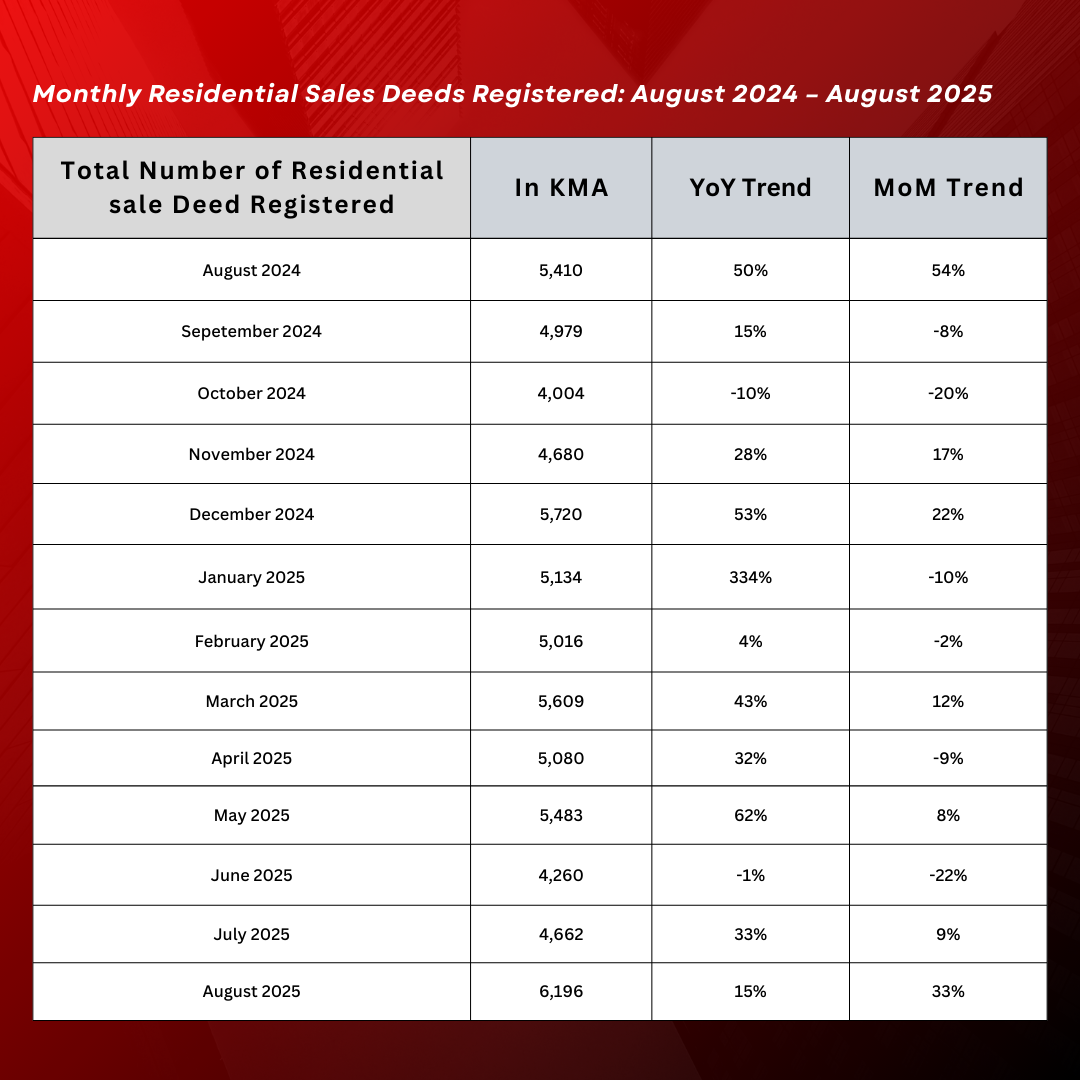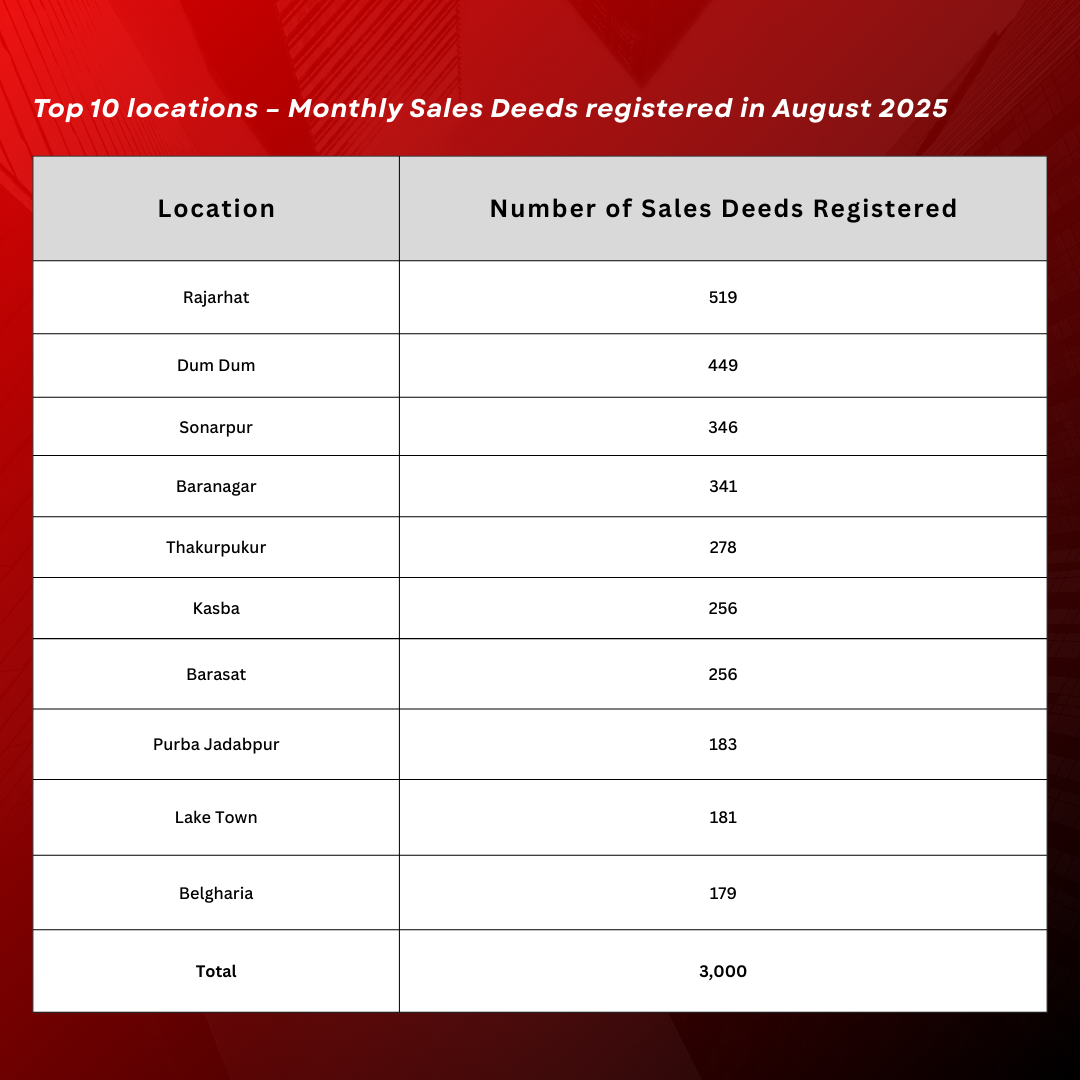Kolkata’s housing market reported a significant surge in August 2025, reflecting the build-up to the festive season and improved consumer sentiment across the city’s suburban and established corridors. According to Knight Frank India, the Kolkata Metropolitan Area (KMA) recorded 6,196 residential property registrations in August. This marks a 15% year-on-year (YoY) growth and a sharp 33% increase month-on-month (MoM) compared to July 2025, highlighting renewed activity in both primary and secondary segments.
The registration data, sourced from the Directorate of Registrations and Stamps Revenue, included transactions across new project sales and resale properties. Market analysts observed that the demand uplift is supported by ongoing infrastructure expansion, affordable housing supply, and stable financing conditions that continue to sustain affordability despite rising property prices.

Year-to-Date Performance Indicates Steady Growth
Between January and August 2025, a total of 41,440 apartments were registered in Kolkata, reflecting a 37% YoY increase over the same period in 2024. The trend suggests that demand is not confined to monthly fluctuations but is part of a larger growth trajectory sustained over the past two years.
In 2023, Kolkata recorded approximately 30,100 units during the same eight-month period, which highlights the acceleration witnessed in 2025. With the festive season ahead, the momentum is expected to continue through September and October, which are traditionally high-transaction months.
Apartment Size and Pricing Trends
The analysis of apartment sizes provides insights into changing buyer behavior:
- Mid-sized homes (501–1,000 sq. ft.) formed the backbone of the market, representing 55% of all registrations, up from 48% in August 2024. This segment continues to attract salaried professionals and nuclear families seeking affordability with adequate space.
- Compact units (0–500 sq. ft.) contributed 32%, underscoring the enduring demand for entry-level housing, particularly from first-time buyers.
- Large homes (1,000+ sq. ft.) rose to a 13% share, nearly doubling from 7% a year earlier, indicating aspirational upgrading and rising acceptance of premium units.
In pricing terms, the average transaction in affordable zones such as North Kolkata and parts of South Kolkata continues to hover between ₹3,500–₹4,500 per sq. ft., while emerging hubs like Rajarhat and New Town command ₹5,000–₹6,500 per sq. ft. depending on amenities and project positioning. Premium developments in central Kolkata and EM Bypass areas are seeing transactions upwards of ₹7,500 per sq. ft.
Zone-Level and Micro-Market Distribution
The demand distribution across Kolkata’s four zones reveals a clear concentration:
- North Zone accounted for 35% of registrations, led by affordability and accessibility in Dum Dum, Baranagar, Barasat, Lake Town, and Belgharia.
- South Zone followed closely at 34%, with Sonarpur, Narendrapur, and Garia remaining strong suburban pockets.
- East Zone, led by Rajarhat and New Town, contributed 22%, while the West Zone accounted for the balance.
In terms of micro-markets, Rajarhat led with 519 registrations, followed by Dum Dum (449) and Sonarpur (346). Together, the top 10 sub-markets accounted for 48% of total registrations, reflecting concentrated demand in pockets with better connectivity and infrastructure support.
Rajarhat and New Town continue to attract working professionals employed in IT and service-sector hubs, while Dum Dum’s strong rail and metro linkages sustain its residential appeal. Sonarpur and Narendrapur cater to price-sensitive buyers seeking affordable housing with improving transport links.

Infrastructure Drivers Reinforcing Demand
Ongoing infrastructure projects have played a decisive role in strengthening Kolkata’s real estate activity:
- Metro Rail Expansion: The extension of multiple metro corridors toward Garia, Joka, and Salt Lake Sector V has enhanced accessibility for suburban areas.
- Road Corridors: Upgrades to EM Bypass and state highways leading into Rajarhat, Barasat, and Sonarpur are reducing commute times.
- Employment Clusters: The IT/ITeS corridor around Salt Lake and New Town, along with industrial hubs in Howrah and Dankuni, has created sustained residential demand in adjoining zones.
These factors have helped balance demand between affordable suburban locations and more premium, centrally located markets.
Financing, Affordability, and Buyer Profiles
Despite fluctuations in home loan rates over the past two years, the financing environment has remained relatively stable in 2025. Most banks and housing finance companies continue to offer mortgage rates in the 8.25%–9% range, ensuring that EMI affordability remains within reach for middle-income households.
Buyer profiles indicate that a large proportion of registrations are from salaried professionals in IT, banking, and services, while small business owners and NRIs also contribute to the growing demand for mid-to-premium housing.
Developers have responded to the strong demand by ramping up launches, particularly in East and South Kolkata. Local developers continue to dominate affordable projects in Barasat, Sonarpur, and Narendrapur, while larger national developers are focusing on mid-segment and premium offerings in Rajarhat, EM Bypass, and New Town.
The supply pipeline for the festive season includes both affordable units under ₹40 lakh and premium projects priced above ₹1.2 crore, widening the spectrum of options for buyers.
Comparative Context: Kolkata vs. Other Metros
While Kolkata’s August growth rate of 15% YoY is strong, it remains relatively modest compared to the larger base activity in markets such as Mumbai and Bengaluru. For instance, Mumbai Metropolitan Region (MMR) crossed over 12,000 registrations in August 2025, while Bengaluru recorded nearly 9,000 units.
However, Kolkata’s consistent growth from a lower base reflects greater stability, with affordability acting as the primary driver. Unlike NCR or Mumbai, speculative activity remains limited in Kolkata, which has helped maintain balanced pricing trends.
According to Shishir Baijal, Chairman and Managing Director, Knight Frank India, the consistent rise in registrations indicates strong consumer confidence in Kolkata’s housing market. He highlighted that the growth in larger-unit registrations suggests a gradual shift toward premium housing, supported by improved infrastructure and a favorable financing environment.
Mr. Baijal added that festive sentiment combined with structural drivers like affordability and connectivity is expected to sustain activity through the remainder of 2025.
Analysts expect the city to benefit from three key structural drivers. Festive season demand between September and November is projected to provide the highest volumes of the year, with developers aligning their launch pipelines accordingly. The rising share of larger apartments indicates a premiumisation trend, suggesting that while affordability will remain the primary driver, Kolkata’s housing market is beginning to diversify into higher-value segments. Infrastructure improvements, particularly the continued expansion of metro corridors and road upgrades, will sustain the residential potential of peripheral and suburban zones.









.png)